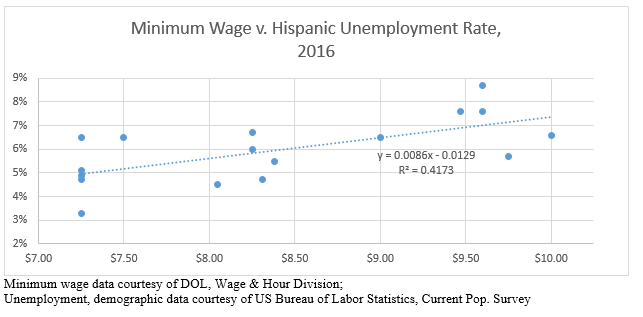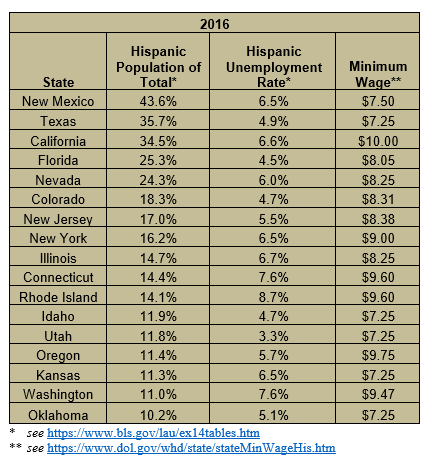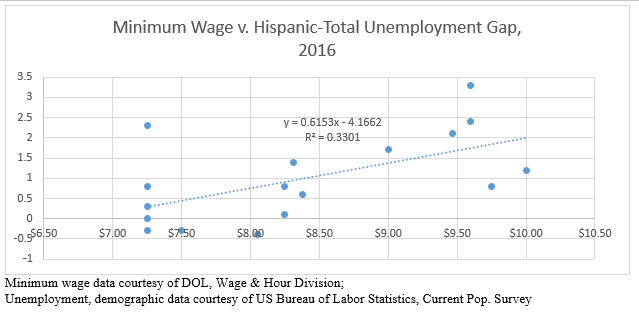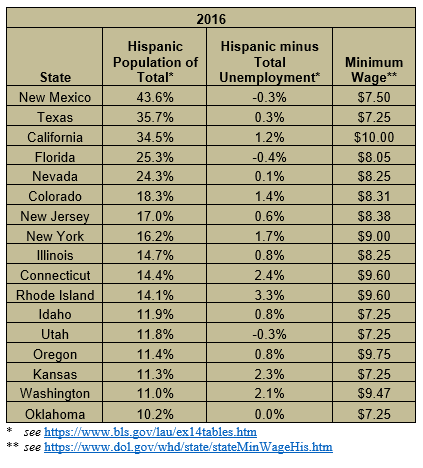Higher minimum wages hurt Hispanic workers most, 2016 data suggests
By Daniel Honchariw
While advocates of raising the minimum wage often argue that doing so will benefit Nevada’s minority communities, an analysis of economic data from the Bureau of Labor Statistics suggests precisely the opposite — especially when it comes to Hispanic unemployment.
Consider these two related trends:
1) As minimum wages increase, so does Hispanic unemployment.
In the 17 states whose Hispanic population exceeded 10 percent of their total population in 2016 — which include Nevada — higher minimum wages correlate significantly with higher rates of Hispanic unemployment.

In the above scatterplot, each point represents a state whose Hispanic population exceeded 10 percent of its total population for 2016.
Generally, the chart shows that Hispanic unemployment tends to be higher in states where minimum wages are also relatively higher.
The regression equation (y=) suggests that each $1 increase to the minimum wage is associated with a .86-pt increased rate of unemployment for Hispanics.
For example, a $12 minimum wage, as Senate Bill 106 proposes, is associated with an unemployment rate of 9 percent for Hispanics, per the regression model.
Similarly, a $15 minimum wage, as Assembly Bill 175 proposes, is associated with an unemployment rate of 11.6 percent for Hispanics.

2) As minimum wages increase, the gap between Hispanic unemployment and total unemployment widens.
In those same 17 states, higher minimum wages are associated with larger gaps between the unemployment rates of Hispanics and those for all unemployed.

Generally, the chart shows that the gap between Hispanic unemployment and total unemployment (Hispanic – Total) tends to be higher in states whose minimum wages are relatively higher.
The regression equation (y=) suggests that each $1 increase to the minimum wage increases the gap between Hispanic unemployment and total unemployment by .62-pts.
To illustrate with a hypothetical:
- With a minimum wage of $8, Hispanic unemployment might be 6 percent while total unemployment is 5 percent.
- If the minimum wage increased to $9, the model suggests that Hispanic unemployment might increase to 7 percent while total unemployment also increases, but only to 5.38 percent — thus increasing the gap (Hispanic – Total) by .62-pts.
Thus, not only do higher minimum wages seem to hurt Hispanics, they hurt them disproportionately compared to other racial demographics.

Other studies have observed a similar effect of increased minimum wages upon the unemployment gap for black workers and, in particular, black youth.
From the PanAm Post:
Before the [Federal Labor Standards Act], the black-white unemployment gap was insignificant, never permanently exceeding 1 percent. But since the introduction of the minimum wage, the gap has increased . . .
In a study of over 600,000 data points, focusing on 16 to 24-year-old males without a high school diploma, the Employment Policies Institute found that every 10 percent increase in a federal or state minimum wage decreased black youth employment by 6.5 percent.
Of course, these and all similar regression models do not prove causation (e.g., x leads to y) but merely, in each instance, a significant correlation.
However, the strength and direction of the associations should make it difficult for even the most vocal advocates for a higher minimum wage to ignore — especially those whose ostensible purpose is to help minority communities.
Daniel Honchariw, MPA is a policy researcher and analyst with NPRI.